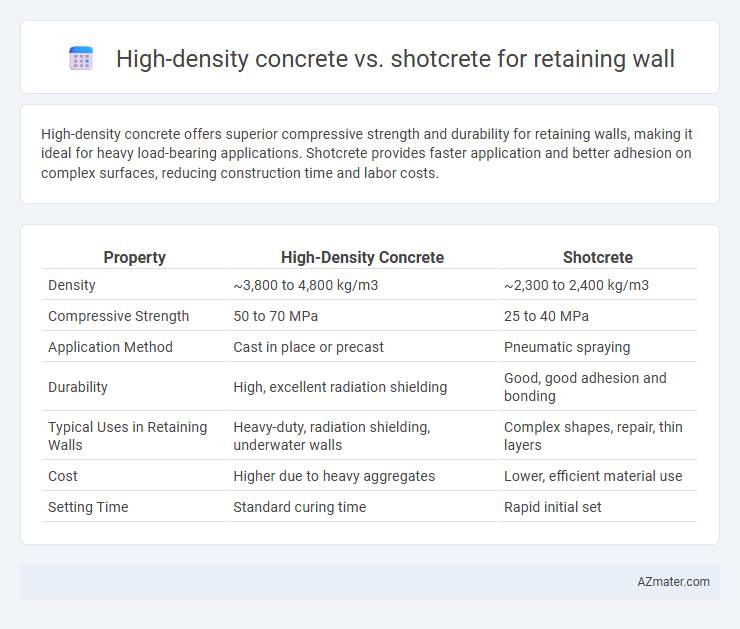High-density concrete offers superior compressive strength and durability for retaining walls, making it ideal for heavy load-bearing applications. Shotcrete provides faster application and better adhesion on complex surfaces, reducing construction time and labor costs.
Table of Comparison
| Property | High-Density Concrete | Shotcrete |
|---|---|---|
| Density | ~3,800 to 4,800 kg/m3 | ~2,300 to 2,400 kg/m3 |
| Compressive Strength | 50 to 70 MPa | 25 to 40 MPa |
| Application Method | Cast in place or precast | Pneumatic spraying |
| Durability | High, excellent radiation shielding | Good, good adhesion and bonding |
| Typical Uses in Retaining Walls | Heavy-duty, radiation shielding, underwater walls | Complex shapes, repair, thin layers |
| Cost | Higher due to heavy aggregates | Lower, efficient material use |
| Setting Time | Standard curing time | Rapid initial set |
Overview of Retaining Wall Construction Methods
Retaining wall construction methods primarily use high-density concrete or shotcrete to ensure structural stability and durability. High-density concrete offers increased compressive strength and resistance to environmental loads, making it ideal for heavy retaining walls in high-stress zones. Shotcrete provides a versatile, rapid application with excellent bonding properties, often used for irregular or complex geometries requiring quick setting and reduced formwork.
What is High-Density Concrete?
High-density concrete is a specialized concrete type characterized by its increased density due to the inclusion of heavyweight aggregates like barite, magnetite, or hematite, providing superior strength and radiation shielding properties. This material is often utilized in engineering applications requiring enhanced load-bearing capacity and durability, such as heavy retaining walls subjected to substantial earth pressure. In comparison to shotcrete--concrete sprayed at high velocity--high-density concrete offers greater compressive strength and longevity but requires more precise placement techniques and curing conditions.
What is Shotcrete?
Shotcrete is a type of concrete conveyed through a hose and pneumatically projected at high velocity onto surfaces, commonly used for retaining walls due to its high adhesion and ability to conform to complex shapes. It offers quick application and strong bonding properties, making it effective for stabilizing soil and providing structural support. Compared to high-density concrete, shotcrete provides enhanced flexibility in application and can be reinforced with steel fibers or mesh for increased durability.
Material Properties: High-Density Concrete vs Shotcrete
High-density concrete exhibits superior compressive strength and enhanced radiation shielding due to its heavy aggregates like barite or magnetite, making it ideal for retaining walls requiring high durability and load-bearing capacity. Shotcrete, a pneumatically applied concrete, offers excellent adhesion to irregular surfaces and faster application but typically has lower density and strength compared to high-density concrete. Material properties such as density, compressive strength, and aggregate composition critically influence the structural performance and longevity of retaining walls constructed with either method.
Installation Techniques Comparison
High-density concrete requires formwork and vibration techniques to ensure proper compaction and density during installation, while shotcrete is pneumatically applied directly onto the retaining wall surface, allowing for faster placement without extensive formwork. Shotcrete installation offers flexibility for complex shapes and uneven surfaces, reducing labor and time compared to traditional high-density concrete pouring methods. Both methods require specialized equipment, but shotcrete's nozzle application enhances bond strength and minimizes rebound waste, optimizing the retaining wall's structural integrity.
Structural Integrity and Durability
High-density concrete offers superior compressive strength and enhanced radiation shielding, making it ideal for retaining walls requiring exceptional structural integrity and long-term durability. Shotcrete provides excellent adhesion and rapid application, but its density and strength are generally lower, potentially compromising resistance to heavy loads and environmental impacts over time. Selecting high-density concrete ensures prolonged durability and resistance to moisture, chemical attack, and freeze-thaw cycles compared to shotcrete in critical retaining wall applications.
Cost Analysis: High-Density Concrete vs Shotcrete
High-density concrete typically incurs higher material costs due to its specialized aggregates like barytes or magnetite, leading to increased overall expenses compared to shotcrete, which uses standard concrete mix applied pneumatically. Shotcrete often reduces labor and formwork costs because of faster application and minimal need for molds, contributing to lower installation expenses despite potential rebound waste. Evaluating total cost effectiveness involves balancing the premium on high-density concrete's enhanced durability and load capacity against shotcrete's rapid placement and reduced labor demand for retaining wall construction.
Application Scenarios and Use Cases
High-density concrete is ideal for retaining walls in environments requiring radiation shielding or enhanced structural strength, such as nuclear facilities and heavy industrial sites. Shotcrete is preferred for complex or irregular wall geometries, rapid construction projects, and applications with limited formwork access like slope stabilization and tunneling support. Both materials offer distinct advantages in specific scenarios: high-density concrete delivers superior load-bearing capacity, whereas shotcrete provides versatility and faster installation in challenging terrains.
Environmental Impact Considerations
High-density concrete for retaining walls offers superior radiation shielding but typically requires more energy-intensive materials such as heavyweight aggregates, increasing its environmental footprint compared to shotcrete. Shotcrete, applied pneumatically, reduces waste and material usage due to its efficient placement, leading to lower carbon emissions and minimized site disturbance. Evaluating the environmental impact involves comparing embodied carbon, resource consumption, and construction waste generation between the two materials to support sustainable retaining wall solutions.
Conclusion: Choosing the Right Method for Retaining Walls
High-density concrete provides superior strength and durability for retaining walls, especially in applications requiring enhanced load-bearing capacity and radiation shielding. Shotcrete offers rapid application and excellent adherence to complex shapes, making it ideal for curved or irregular retaining wall designs. Selecting the right method depends on structural requirements, site conditions, and project timelines to ensure long-term stability and cost efficiency.

Infographic: High-density concrete vs Shotcrete for Retaining wall
 azmater.com
azmater.com